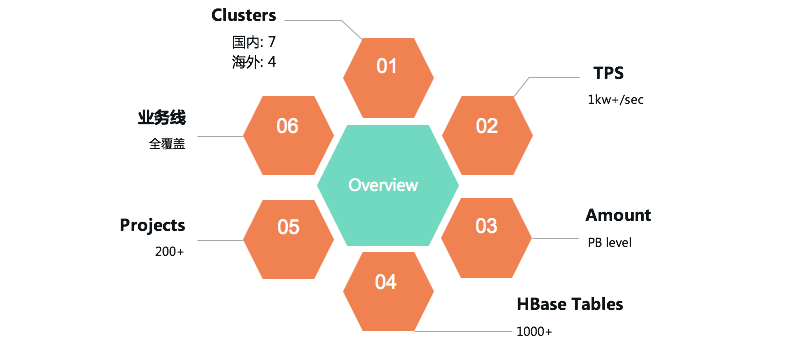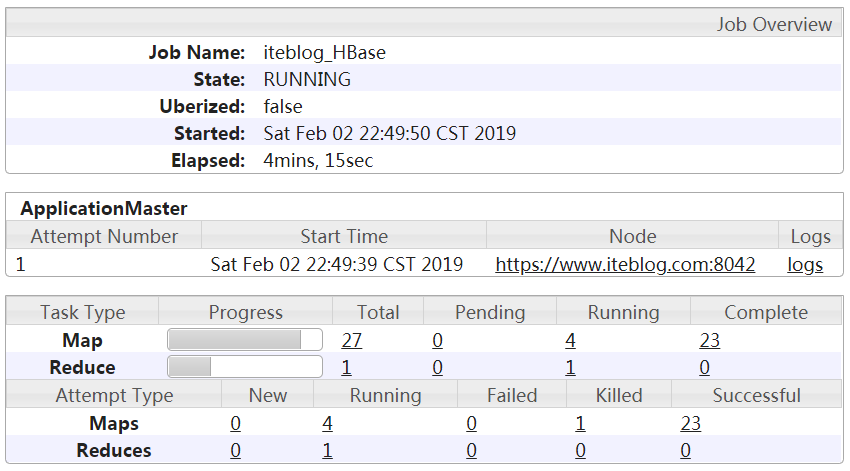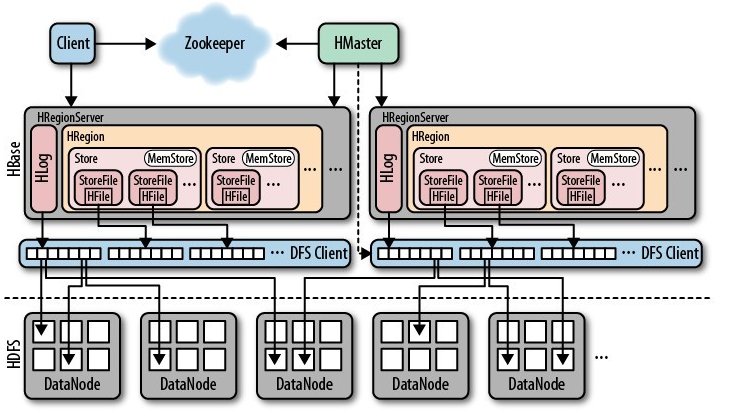在 《HBase Rowkey 设计指南》 文章中,我们介绍了避免数据热点的三种比较常见方法:
- 加盐 - Salting
- 哈希 - Hashing
- 反转 - Reversing
其中在加盐(Salting)的方法里面是这么描述的:给 Rowkey 分配一个随机前缀以使得它和之前排序不同。但是在 Rowkey 前面加了随机前缀,那么我们怎么将这些数据读出来呢?我将分三篇文章来介绍如何读取加盐之后的表,其中每篇文章提供一种方法,主要包括:
- 使用协处理器读取加盐的表
- 使用 Spark 读取加盐的表
- 使用 MapReduce 读取加盐的表
关于协处理器的入门及实战,请参见这里。本文使用的各组件版本:hadoop-2.7.7,hbase-2.0.4,jdk1.8.0_201。
测试数据生成
在介绍如何查询数据之前,我们先创建一张名为 iteblog 的 HBase 表,用于测试。为了数据均匀和介绍的方便,这里使用了预分区,并设置了27个分区,如下:
hbase(main):002:0> create 'iteblog', 'f', SPLITS => ['A', 'B', 'C', 'D', 'E', 'F', 'G', 'H', 'I', 'J', 'K', 'L', 'M', 'N', 'O', 'P', 'Q', 'R', 'S', 'T', 'U', 'V', 'W', 'X', 'Y', 'Z'] 0 row(s) in 2.4880 seconds
然后我们使用下面方法生成了1000000条测试数据。RowKey 的形式为 UID + 当前数据生成时间戳;由于 UID 的长度为4,所以1000000条数据会存在大量的 UID 一样的数据,所以我们使用加盐方法将这些数据均匀分散到上述27个 Region 里面(注意,其实第一个 Region 其实没数据)。具体代码如下:
package com.iteblog.data;
import org.apache.hadoop.conf.Configuration;
import org.apache.hadoop.hbase.HBaseConfiguration;
import org.apache.hadoop.hbase.HConstants;
import org.apache.hadoop.hbase.TableName;
import org.apache.hadoop.hbase.client.*;
import org.apache.hadoop.hbase.util.Bytes;
import java.io.IOException;
import java.util.ArrayList;
import java.util.List;
import java.util.Random;
import java.util.UUID;
public class HBaseDataGenerator {
private static byte[] FAMILY = "f".getBytes();
private static byte[] QUALIFIER_UUID = "uuid".getBytes();
private static byte[] QUALIFIER_AGE = "age".getBytes();
private static char generateLetter() {
return (char) (Math.random() * 26 + 'A');
}
private static long generateUid(int n) {
return (long) (Math.random() * 9 * Math.pow(10, n - 1)) + (long) Math.pow(10, n - 1);
}
public static void main(String[] args) throws IOException {
BufferedMutatorParams bmp = new BufferedMutatorParams(TableName.valueOf("iteblog"));
bmp.writeBufferSize(1024 * 1024 * 24);
Configuration conf = HBaseConfiguration.create();
conf.set(HConstants.ZOOKEEPER_QUORUM, "https://www.iteblog.com:2181");
Connection connection = ConnectionFactory.createConnection(conf);
BufferedMutator bufferedMutator = connection.getBufferedMutator(bmp);
int BATCH_SIZE = 1000;
int COUNTS = 1000000;
int count = 0;
List<Put> putList = new ArrayList<>();
for (int i = 0; i < COUNTS; i++) {
String rowKey = generateLetter() + "-"
+ generateUid(4) + "-"
+ System.currentTimeMillis();
Put put = new Put(Bytes.toBytes(rowKey));
byte[] uuidBytes = UUID.randomUUID().toString().substring(0, 23).getBytes();
put.addColumn(FAMILY, QUALIFIER_UUID, uuidBytes);
put.addColumn(FAMILY, QUALIFIER_AGE, Bytes.toBytes("" + new Random().nextInt(100)));
putList.add(put);
count++;
if (count % BATCH_SIZE == 0) {
bufferedMutator.mutate(putList);
bufferedMutator.flush();
putList.clear();
System.out.println(count);
}
}
if (putList.size() > 0) {
bufferedMutator.mutate(putList);
bufferedMutator.flush();
putList.clear();
}
}
}
运行完上面代码之后,会生成1000000条数据(注意,这里其实不严谨,因为 Rowkey 设计问题,可能会导致重复的 Rowkey 生成,所以实际情况下可能没有1000000条数据。)。我们limit 10条数据看下长成什么样:
hbase(main):001:0> scan 'iteblog', {'LIMIT'=>10}
ROW COLUMN+CELL
A-1000-1550572395399 column=f:age, timestamp=1549091990253, value=54
A-1000-1550572395399 column=f:uuid, timestamp=1549091990253, value=e9b10a9f-1218-43fd-bd01
A-1000-1550572413799 column=f:age, timestamp=1549092008575, value=4
A-1000-1550572413799 column=f:uuid, timestamp=1549092008575, value=181aa91e-5f1d-454c-959c
A-1000-1550572414761 column=f:age, timestamp=1549092009531, value=33
A-1000-1550572414761 column=f:uuid, timestamp=1549092009531, value=19aad8d3-621a-473c-8f9f
A-1001-1550572394570 column=f:age, timestamp=1549091989341, value=64
A-1001-1550572394570 column=f:uuid, timestamp=1549091989341, value=c6712a0d-3793-46d5-865b
A-1001-1550572405337 column=f:age, timestamp=1549092000108, value=96
A-1001-1550572405337 column=f:uuid, timestamp=1549092000108, value=4bf05d10-bb4d-43e3-9957
A-1001-1550572419688 column=f:age, timestamp=1549092014458, value=8
A-1001-1550572419688 column=f:uuid, timestamp=1549092014458, value=f04ba835-d8ac-49a3-8f96
A-1002-1550572424041 column=f:age, timestamp=1549092018816, value=84
A-1002-1550572424041 column=f:uuid, timestamp=1549092018816, value=99d6c989-afb5-4101-9d95
A-1003-1550572431830 column=f:age, timestamp=1549092026605, value=21
A-1003-1550572431830 column=f:uuid, timestamp=1549092026605, value=8c1ff1b6-b97c-4059-9b68
A-1004-1550572395399 column=f:age, timestamp=1549091990253, value=2
A-1004-1550572395399 column=f:uuid, timestamp=1549091990253, value=e240aa0f-c044-452f-89c0
A-1004-1550572403783 column=f:age, timestamp=1549091998555, value=6
A-1004-1550572403783 column=f:uuid, timestamp=1549091998555, value=e8df15c9-02fa-458e-bd0c
10 row(s)
Took 0.1104 seconds
使用协处理器查询加盐之后的表
现在有数据了,我们需要查询所有 UID = 1000 的用户所有历史数据,那么如何查呢?我们知道 UID = 1000 的用户数据是均匀放到上述的27个 Region 里面的,因为经过加盐了,所以这些数据前缀都是类似于 A-,B-,C- 等开头的。其次我们需要知道,每个 Region 其实是有 Start Key 和 End Key 的,这些 Start Key 和 End Key 其实就是我们创建 iteblog 表指定的。如果你看了 《HBase 协处理器入门及实战》 这篇文章,你就知道协处理器的代码其实是在每个 Region 里面执行的;而这些代码在 Region 里面执行的时候是可以拿到当前 Region 的信息,包括了 Start Key 和 End Key,所以其实我们可以将拿到的 Start Key 信息和查询的 UID 进行拼接,这样就可以查询我们要的数据。协处理器处理篇就是基于这样的思想来查询加盐之后的数据的。
定义 proto 文件
为什么需要定义这个请参见 《HBase 协处理器入门及实战》 这篇文章。因为我们查询的时候需要传入查询的参数,比如tableName、 StartKey 、 EndKey 以及是否加盐等标记;同时当查询到结果的时候,我们还需要将数据返回,所以我们定义的 proto 文件如下:
option java_package = "com.iteblog.data.coprocessor.generated";
option java_outer_classname = "DataQueryProtos";
option java_generic_services = true;
option java_generate_equals_and_hash = true;
option optimize_for = SPEED;
message DataQueryRequest {
optional string tableName = 1;
optional string startRow = 2;
optional string endRow = 3;
optional bool incluedEnd = 4;
optional bool isSalting = 5;
}
message DataQueryResponse {
message Cell{
required bytes value = 1;
required bytes family = 2;
required bytes qualifier = 3;
required bytes row = 4;
required int64 timestamp = 5;
}
message Row{
optional bytes rowKey = 1;
repeated Cell cellList = 2;
}
repeated Row rowList = 1;
}
service QueryDataService{
rpc queryByStartRowAndEndRow(DataQueryRequest)
returns (DataQueryResponse);
}
然后我们使用 protobuf-maven-plugin 插件将上面的 proto 生成 java 类,具体如何操作参见 《在 IDEA 中使用 Maven 编译 proto 文件》。我们将生成的 DataQueryProtos.java 类拷贝到 com.iteblog.data.coprocessor.generated 包里面。
编写协处理器代码
有了请求和返回的类,现在我们需要编写协处理器的处理代码了,结合上面的分析,协处理器的代码实现如下:
package com.iteblog.data.coprocessor;
import com.google.protobuf.ByteString;
import com.google.protobuf.RpcCallback;
import com.google.protobuf.RpcController;
import com.google.protobuf.Service;
import com.iteblog.data.coprocessor.generated.DataQueryProtos.QueryDataService;
import com.iteblog.data.coprocessor.generated.DataQueryProtos.DataQueryRequest;
import com.iteblog.data.coprocessor.generated.DataQueryProtos.DataQueryResponse;
import org.apache.hadoop.hbase.Cell;
import org.apache.hadoop.hbase.CoprocessorEnvironment;
import org.apache.hadoop.hbase.client.Get;
import org.apache.hadoop.hbase.client.Result;
import org.apache.hadoop.hbase.client.Scan;
import org.apache.hadoop.hbase.coprocessor.CoprocessorException;
import org.apache.hadoop.hbase.coprocessor.RegionCoprocessor;
import org.apache.hadoop.hbase.coprocessor.RegionCoprocessorEnvironment;
import org.apache.hadoop.hbase.regionserver.InternalScanner;
import org.apache.hadoop.hbase.shaded.protobuf.ResponseConverter;
import org.apache.hadoop.hbase.util.Bytes;
import java.io.IOException;
import java.util.ArrayList;
import java.util.Collections;
import java.util.List;
public class SlatTableDataSearch extends QueryDataService implements RegionCoprocessor {
private RegionCoprocessorEnvironment env;
public Iterable<Service> getServices() {
return Collections.singleton(this);
}
@Override
public void queryByStartRowAndEndRow(RpcController controller,
DataQueryRequest request,
RpcCallback<DataQueryResponse> done) {
DataQueryResponse response = null;
String startRow = request.getStartRow();
String endRow = request.getEndRow();
String regionStartKey = Bytes.toString(this.env.getRegion().getRegionInfo().getStartKey());
if (request.getIsSalting()) {
String startSalt = null;
if (null != regionStartKey && regionStartKey.length() != 0) {
startSalt = regionStartKey;
}
if (null != startSalt && null != startRow) {
startRow = startSalt + "-" + startRow;
endRow = startSalt + "-" + endRow;
}
}
Scan scan = new Scan();
if (null != startRow) {
scan.withStartRow(Bytes.toBytes(startRow));
}
if (null != endRow) {
scan.withStopRow(Bytes.toBytes(endRow), request.getIncluedEnd());
}
try (InternalScanner scanner = this.env.getRegion().getScanner(scan)) {
List<Cell> results = new ArrayList<>();
boolean hasMore;
DataQueryResponse.Builder responseBuilder = DataQueryResponse.newBuilder();
do {
hasMore = scanner.next(results);
DataQueryResponse.Row.Builder rowBuilder = DataQueryResponse.Row.newBuilder();
if (results.size() > 0) {
Cell cell = results.get(0);
rowBuilder.setRowKey(ByteString.copyFrom(cell.getRowArray(), cell.getRowOffset(), cell.getRowLength()));
for (Cell kv : results) {
buildCell(rowBuilder, kv);
}
}
responseBuilder.addRowList(rowBuilder);
results.clear();
} while (hasMore);
response = responseBuilder.build();
} catch (IOException e) {
ResponseConverter.setControllerException(controller, e);
}
done.run(response);
}
private void buildCell(DataQueryResponse.Row.Builder rowBuilder, Cell kv) {
DataQueryResponse.Cell.Builder cellBuilder = DataQueryResponse.Cell.newBuilder();
cellBuilder.setFamily(ByteString.copyFrom(kv.getFamilyArray(), kv.getFamilyOffset(), kv.getFamilyLength()));
cellBuilder.setQualifier(ByteString.copyFrom(kv.getQualifierArray(), kv.getQualifierOffset(), kv.getQualifierLength()));
cellBuilder.setRow(ByteString.copyFrom(kv.getRowArray(), kv.getRowOffset(), kv.getRowLength()));
cellBuilder.setValue(ByteString.copyFrom(kv.getValueArray(), kv.getValueOffset(), kv.getValueLength()));
cellBuilder.setTimestamp(kv.getTimestamp());
rowBuilder.addCellList(cellBuilder);
}
/**
* Stores a reference to the coprocessor environment provided by the
* {@link org.apache.hadoop.hbase.regionserver.RegionCoprocessorHost} from the region where this
* coprocessor is loaded. Since this is a coprocessor endpoint, it always expects to be loaded
* on a table region, so always expects this to be an instance of
* {@link RegionCoprocessorEnvironment}.
*
* @param env the environment provided by the coprocessor host
* @throws IOException if the provided environment is not an instance of
* {@code RegionCoprocessorEnvironment}
*/
@Override
public void start(CoprocessorEnvironment env) throws IOException {
if (env instanceof RegionCoprocessorEnvironment) {
this.env = (RegionCoprocessorEnvironment) env;
} else {
throw new CoprocessorException("Must be loaded on a table region!");
}
}
@Override
public void stop(CoprocessorEnvironment env) {
// nothing to do
}
}
大家可以看到,这里面的代码框架和 《HBase 协处理器入门及实战》 里面介绍的 HBase 提供的 RowCountEndpoint 示例代码很类似。主要逻辑在 queryByStartRowAndEndRow 函数实现里面。我们通过 DataQueryRequest 拿到客户端查询的表,StartKey 和 EndKey 等数据。通过 this.env.getRegion().getRegionInfo().getStartKey() 可以拿到当前 Region 的 StartKey,然后再和客户端传进来的 StartKey 和 EndKey 进行拼接就可以拿到完整的 Rowkey 前缀。剩下的查询就是正常的 HBase Scan 代码了。
现在我们将 SlatTableDataSearch 类进行编译打包,并部署到 HBase 表里面去,具体如何部署参见 《HBase 协处理器入门及实战》
协处理器客户端代码编写
到这里,我们的协处理器服务器端的代码和部署已经完成了,现在我们需要编写协处理器客户端代码。其实也很简单,如下:
package com.iteblog.data;
import com.iteblog.data.coprocessor.generated.DataQueryProtos.QueryDataService;
import com.iteblog.data.coprocessor.generated.DataQueryProtos.DataQueryRequest;
import com.iteblog.data.coprocessor.generated.DataQueryProtos.DataQueryResponse;
import com.iteblog.data.coprocessor.generated.DataQueryProtos.DataQueryResponse.*;
import org.apache.hadoop.conf.Configuration;
import org.apache.hadoop.hbase.HBaseConfiguration;
import org.apache.hadoop.hbase.TableName;
import org.apache.hadoop.hbase.client.Connection;
import org.apache.hadoop.hbase.client.ConnectionFactory;
import org.apache.hadoop.hbase.client.HTable;
import org.apache.hadoop.hbase.ipc.CoprocessorRpcUtils.BlockingRpcCallback;
import org.apache.hadoop.hbase.ipc.ServerRpcController;
import java.util.LinkedList;
import java.util.List;
import java.util.Map;
public class DataQuery {
private static Configuration conf = null;
static {
conf = HBaseConfiguration.create();
conf.set("hbase.zookeeper.quorum", "https://www.iteblog.com:2181");
}
static List<Row> queryByStartRowAndStopRow(String tableName,
String startRow, String stopRow,
boolean isIncludeEnd, boolean isSalting) {
final DataQueryRequest.Builder requestBuilder = DataQueryRequest.newBuilder();
requestBuilder.setTableName(tableName);
requestBuilder.setStartRow(startRow);
requestBuilder.setEndRow(stopRow);
requestBuilder.setIncluedEnd(isIncludeEnd);
requestBuilder.setIsSalting(isSalting);
try {
Connection connection = ConnectionFactory.createConnection(conf);
HTable table = (HTable) connection.getTable(TableName.valueOf(tableName));
Map<byte[], List<Row>> result = table.coprocessorService(QueryDataService.class,
null, null, counter -> {
ServerRpcController controller = new ServerRpcController();
BlockingRpcCallback<DataQueryResponse> call = new BlockingRpcCallback<>();
counter.queryByStartRowAndEndRow(controller, requestBuilder.build(), call);
DataQueryResponse response = call.get();
if (controller.failedOnException()) {
throw controller.getFailedOn();
}
return response.getRowListList();
});
List<Row> list = new LinkedList<>();
for (Map.Entry<byte[], List<Row>> entry : result.entrySet()) {
if (null != entry.getKey()) {
list.addAll(entry.getValue());
}
}
return list;
} catch (Throwable e) {
e.printStackTrace();
}
return null;
}
public static void main(String[] args) {
List<Row> rows = queryByStartRowAndStopRow("iteblog", "1000", "1001", false, true);
if (null != rows) {
System.out.println(rows.size());
for (DataQueryResponse.Row row : rows) {
List<DataQueryResponse.Cell> cellListList = row.getCellListList();
for (DataQueryResponse.Cell cell : cellListList) {
System.out.println(row.getRowKey().toStringUtf8() + " \t " +
"column=" + cell.getFamily().toStringUtf8() +
":" + cell.getQualifier().toStringUtf8() + ", " +
"timestamp=" + cell.getTimestamp() + ", " +
"value=" + cell.getValue().toStringUtf8());
}
}
}
}
}
我们运行上面的代码,可以得到如下的输出:
A-1000-1550572395399 column=f:age, timestamp=1549091990253, value=54
A-1000-1550572395399 column=f:uuid, timestamp=1549091990253, value=e9b10a9f-1218-43fd-bd01
A-1000-1550572413799 column=f:age, timestamp=1549092008575, value=4
A-1000-1550572413799 column=f:uuid, timestamp=1549092008575, value=181aa91e-5f1d-454c-959c
A-1000-1550572414761 column=f:age, timestamp=1549092009531, value=33
A-1000-1550572414761 column=f:uuid, timestamp=1549092009531, value=19aad8d3-621a-473c-8f9f
B-1000-1550572388491 column=f:age, timestamp=1549091983276, value=1
B-1000-1550572388491 column=f:uuid, timestamp=1549091983276, value=cf720efe-2ad2-48d6-81b8
B-1000-1550572392922 column=f:age, timestamp=1549091987701, value=7
B-1000-1550572392922 column=f:uuid, timestamp=1549091987701, value=8a047118-e130-48cb-adfe
hbase(main):020:0> scan 'iteblog', {STARTROW => 'A-1000', ENDROW => 'A-1001'}
ROW COLUMN+CELL
A-1000-1550572395399 column=f:age, timestamp=1549091990253, value=54
A-1000-1550572395399 column=f:uuid, timestamp=1549091990253, value=e9b10a9f-1218-43fd-bd01
A-1000-1550572413799 column=f:age, timestamp=1549092008575, value=4
A-1000-1550572413799 column=f:uuid, timestamp=1549092008575, value=181aa91e-5f1d-454c-959c
A-1000-1550572414761 column=f:age, timestamp=1549092009531, value=33
A-1000-1550572414761 column=f:uuid, timestamp=1549092009531, value=19aad8d3-621a-473c-8f9f
3 row(s)
Took 0.0569 seconds
可以看到,和我们使用 HBase Shell 输出的一致,而且我们还把所有的 UID = 1000 的数据拿到了。好了,到这里,使用协处理器查询 HBase 加盐之后的表已经算完成了,明天我将介绍使用 Spark 如何查询加盐之后的表。
本博客文章除特别声明,全部都是原创!原创文章版权归过往记忆大数据(过往记忆)所有,未经许可不得转载。
本文链接: 【HBase 中加盐(Salting)之后的表如何读取:协处理器篇】(https://www.iteblog.com/archives/2507.html)









